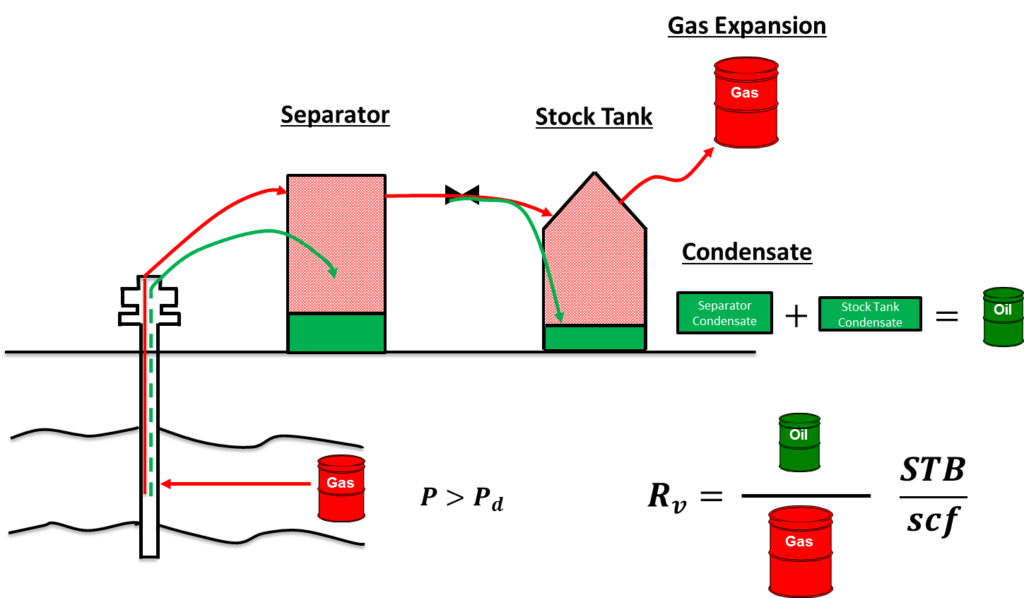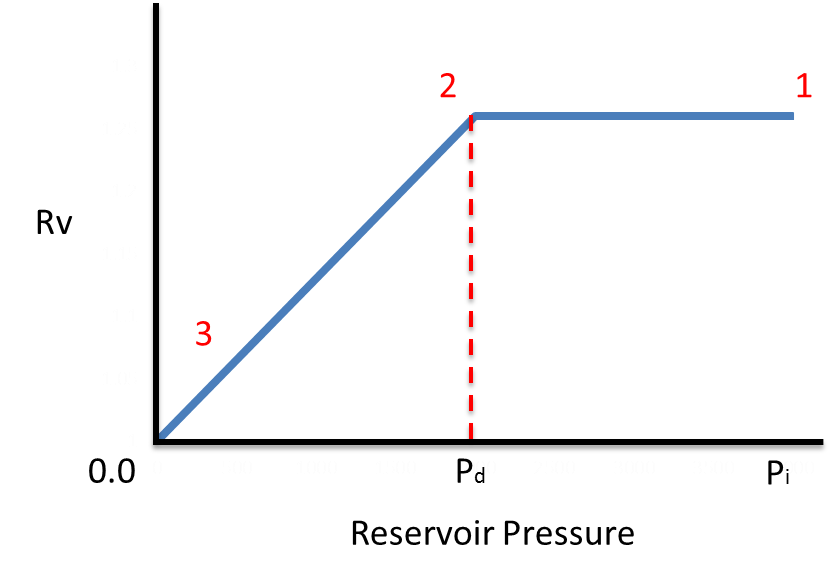In past discussions we looked at how to keep track of reservoir produced volumes below and above the bubble point for oil reservoirs. For gas reservoirs, we do the exact same thing using a separate set of formation volume factors and ratios. In some gas reservoirs, condensate evolves out of the gas as it is transported from the reservoir to the surface. Condensate, also referred to as volatilized oil, is essentially liquid oil that drops out of the gas as pressure decreases. The figure below illustrates the concept of volatilized oil for a undersaturated gas reservoir (i.e. reservoir pressure that is above the dew point).

From the figure above, as gas is transported from the reservoir to the surface, (1) condensate evolves out of the gas and (2) the gas phase expands due to a reduction in pressure. The condensate gets separated in seperators at the surface. Sometimes this occurs in multiple stages. The sum of all the liquids recovered at each stage of separation is the total gas condensate dropped out by a given volume of free gas as long as reservoir pressure is above the dew point. To account for the condensate evolved from the gas, petroleum engineers have defined a volatilized oil-gas ratio (![]() ). The volatilized oil-gas ratio is defined as the ratio of stock tank oil to surface gas contained in a reservoir vapor phase at reservoir conditions. Another way to think about is it is one STB of oil evolved out of the gas phase divided by the amount of surface gas it took to produce that one stock tank barrel of oil. The volatilized oil-gas ratio is has units of STB/scf. The figure below shows another illustration of how volatilized oil-gas ratio is defined:
). The volatilized oil-gas ratio is defined as the ratio of stock tank oil to surface gas contained in a reservoir vapor phase at reservoir conditions. Another way to think about is it is one STB of oil evolved out of the gas phase divided by the amount of surface gas it took to produce that one stock tank barrel of oil. The volatilized oil-gas ratio is has units of STB/scf. The figure below shows another illustration of how volatilized oil-gas ratio is defined:

From the figure above it is clear that the condensate is dropped out exclusively by the free gas phase in the reservoir. At reservoir pressures above the dew point, any oil produced at the surface is considered to be condensate. Therefore it can be used to calculate the volatilized oil-gas ratio. However, if the reservoir pressure falls below the dew point, the volatilized oil gas ratio will change. The figure below shows the typical shape of the volatilized oil-gas ratio as a function of reservoir pressure:

The figure above shows how the volatilized oil-gas ratio changes as a function of pressure at constant reservoir temperature. The process can be described in steps:
- 1-2: As the reservoir pressure is decreased from initial reservoir pressure (
 ) to dew point pressure (
) to dew point pressure ( ), the volatilized oil-gas ratio is constant. This is because, above the dew point there is no free oil in the reservoir. So the amount of oil that comes out at the surface will condensate only and the volatilized oil-gas ratio will remain constant.
), the volatilized oil-gas ratio is constant. This is because, above the dew point there is no free oil in the reservoir. So the amount of oil that comes out at the surface will condensate only and the volatilized oil-gas ratio will remain constant. - 2-3: As the reservoir pressure falls below dew point pressure, condensate will continuously evolve in the reservoir. This leaves less condensate dissolved in the gas, therefore the volatilized oil-gas ratio steadily declines below the dew point pressure.
The concept of volatilized oil-gas ratio is important in material balance calculations and keeping track of all the volumes produced. Next we will discuss another term used in gas reservoir engineering calculations called the gas two phase formation volume factor.